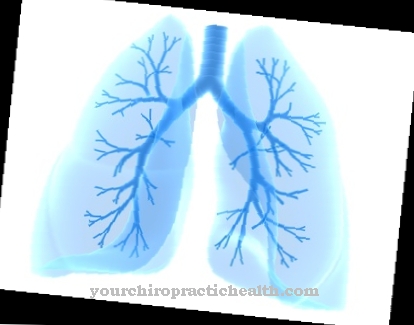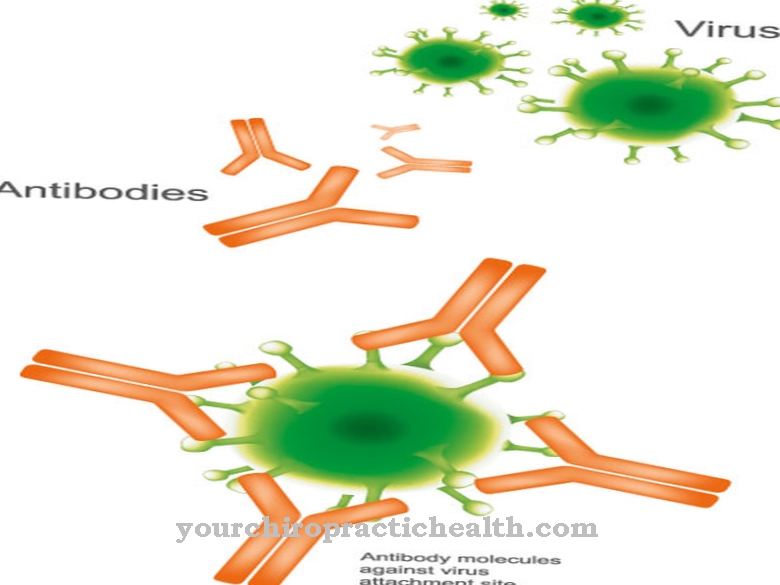Of the Krabbe's disease is a hereditary storage disease that causes demyelination of the nervous system. The cause of this phenomenon is a chromosomal mutation. So far, the disease is incurable.
What is Krabbe Disease?

© Giovanni Cancemi - stock.adobe.com
Under the Krabbe's disease the physician understands a rare storage disease from the cerebroside family. The disease is also called Globoidal cell leukodystrophy known. The disease is named after the Danish doctor Knud Krabbe. He was the first to describe the autosomal recessive hereditary disease in detail. In Krabbe's disease, a gene mutation causes toxic compounds to accumulate in the body. In addition to the infantile form, there is a special form of the disease that only sets in in adulthood.
A differentiation from Krabbe's disease is Gaucher's disease. This is also a hereditary storage disease based on a gene mutation. In both diseases, those affected lack an enzyme. In Krabbe's disease, it is the enzyme β-galactosidase. Without galactocerebrosidase, demyelination of the nervous system occurs. Gaucher's disease, on the other hand, involves the enzyme glucocerebrosidase, the lack of which has other effects on the organism.
causes
The cause of Krabbe's disease is a defect in the GALC gene. This gene is located on chromosome 14 and is in section q3.1. In biological translation, the mRNA is translated into proteins based on the template. The GALC gene is the building instruction for the enzymatic galactocerebrosidase during translation. A defect in this gene causes translation errors. In the case of Krabbe's disease, a deletion takes place, which means that the affected person completely lacks the enzyme galactocerebrosidase.
As a result, substances accumulate in the organism that arise during the myelin metabolism. Myelin is the isolation of the nerve fibers in the nervous system. The enzyme galactocerebrosidase breaks down the metabolic products of myelin into galactose and galactocerebrosides. If the enzyme is missing, this breakdown can no longer take place. In particular, galactocerebroside and psychosin accumulate. Psychosin is harmful to oligodendrocytes, which ensure the maintenance of myelin.
Symptoms, ailments & signs
Patients with Krabbe's disease suffer from similar symptoms as patients with multiple sclerosis. Both diseases are associated with demyelination of the nerve tracts. This demyelination is often initially noticeable as sensory disorders. Due to the breakdown of the myelin, the nerve conduction speed of the patient is reduced. Depending on which area of the nervous system is currently affected, motor and cognitive impairments can occur.
Paralysis is conceivable, but the ability to perceive is also impaired. For example, blindness may occur under certain circumstances. Deafness is also possible. The patient's reflexes can usually no longer be triggered. In infantile Krabbe's disease, the symptoms usually begin after a few months of age. The infants affected suffer screaming attacks and are easily irritated. The legs often stretch tonic in response to external stimuli. Development comes to a standstill and the arms bend constantly. Hyperventilation and fever set in.
Diagnosis & course of disease
When diagnosing Krabbe's disease, the doctor must primarily consider multiple sclerosis in the differential diagnosis. A CSF sample can provide information about the cause of demyelination. In multiple sclerosis, immunoglobulins are found in the liquor despite the blood-brain barrier. In Krabbe's disease, on the other hand, the proteins are increased. To confirm the diagnosis, galactocerebrosidase can be detected in the leukocytes.
Fibroblast cultures can also help in confirming the diagnosis. The same applies to a genetic analysis that reveals a mutation in the corresponding chromosome. The prognosis for the infantile form of Krabbe's disease is poor. Affected people die at an average age of 13 months. The prognosis is more favorable for the special form in adulthood, since the disease progresses more slowly in this case.
Complications
In most cases, people with Krabbe's disease suffer from various disorders of sensitivity and paralysis. As a result, the everyday life of the patient is considerably restricted and those affected depend on the help of other people. The quality of life of the patient is also significantly reduced by Krabbe's disease.
It is not uncommon for the disease to lead to cognitive or motor impairments and can thus significantly impair the development of children. Furthermore, teasing or bullying can occur in children, which can often lead to depression or other psychological complaints.
Furthermore, Krabbe's disease can cause blindness or deafness. Sudden blindness can lead to severe depression, especially in young people. Babies often cry because of the symptoms and also suffer from a fever. Relatives or parents can also develop psychological complaints or depression as a result of the illness.
Treatment can usually only be carried out with the help of medication. However, stem cells can also be transplanted. There are no particular complications. Krabbe's disease may reduce the life expectancy of those affected.
When should you go to the doctor?
The classic form of the storage disease Krabbe's disease is already recognizable in early childhood. If the family knows that the disease is hereditary, they will see a doctor quickly. The risk that one of the family's children will develop Krabbe's disease is high. The siblings, however, only get sick with a 1: 4 chance. Krabbe's disease is often discovered during prenatal diagnosis.
Since the disease cannot be cured, termination of pregnancy is possible if medically indicated. Globoid cell leukodystrophy is always fatal in the infantile form. The children usually die before they have reached the age of one. Apart from the symptom-relieving administration of painkillers for palliative purposes, there is not much for the attending physician to do. The doctor can also prescribe muscle-relaxing preparations and sedatives.
The therapeutic options for the special forms of Krabbe's disease that appear later are just as poor. The course of the disease is slower and the symptoms may not be quite as serious. In the late form of Krabbe's disease, doctors can sometimes achieve improvements with a stem cell transplant.
Treatment & Therapy
Krabbe's disease is considered incurable. A causal therapy is not available. In contrast to the demyelination of multiple sclerosis, the course of Krabbe's disease cannot be delayed. Instead of extending life, the therapeutic focus is therefore on improving the quality of life. In order to achieve this goal, drug therapies with antispasmodic antispasmodics are often carried out.
Painkillers and sedatives can also have positive symptomatic effects. The parents of affected children are usually looked after by psychotherapy. In late forms of Krabbe's disease, unlike the infantile form, a delay in the course of the disease is possible. In this regard, stem cell therapies have achieved good results. As part of this therapy, blood stem cells from a donor are transferred to the patient.
However, this allogeneic stem cell transplant is always a risky business. In particular, inflammatory reactions and infections are possible. With advances in gene therapy, it may be possible in the future to cure those affected by Krabbe's disease. At the moment, however, this scenario is still a long way off.
Outlook & forecast
Krabbe's disease has a poor prognosis. Many children die within twelve to 13 months of birth. Life expectancy can be extended with a stem cell transplant. A cure for the genetic disease is not yet possible. The condition can only be treated palliatively. The symptoms progress until the child dies, and finally a largely unresponsive state occurs. Death occurs as a result of complications such as respiratory failure or cardiovascular failure.
The late infantile or juvenile form of Krabbe's disease offers a more favorable prognosis. Children with the juvenile form can live to be several years old. The first symptoms appear much later, which means that the development of the immune system is largely complete. The better protection of the body opens up additional treatment options and the prospect of a relatively symptom-free life.
However, the juvenile form is also fatal. The disease is a great burden for the child and relatives. That is why affected families receive detailed advice, during which the prognosis and treatment options are also discussed. The association ELA Germany e. V. provides further details on the prognosis for Krabbe's disease.
prevention
Chromosome mutations such as Krabbe's disease cannot be directly prevented. Families planning their children can, however, use the sequence analysis of their DNA to assess the risk of passing on hereditary diseases. If a child was affected by Krabbe's disease, there is a probability of around 25 percent for other children.
Aftercare
Krabbe's disease is currently not curable as a genetic condition and there is accordingly no medical follow-up in the narrower sense. The course always ends fatally. If the condition already occurs in childhood or after birth, parents should be well informed about Krabbe's disease and the therapy. Only then is symptomatic therapy aimed primarily at controlling irritability and spastic paralysis. In the later stages of the disease, palliative measures are the most important.
Symptoms are the same in people who develop the disease later. However, the process is slower, which can give relatives more time to prepare and still spend time with the person with Krabbe's disease. Follow-up care is provided for relatives in the form of psychological care, if this is desired. A genetic test can also provide information about the extent to which there is a risk for further offspring to suffer from Krabbe disease.
A stem cell transplant is conceivable. However, no cure can be brought about by this either. If a stem cell transplant is attempted, the necessary follow-up measures are also required. This means, for example, a special protection of the recipient from germs, because his immune system has to be weakened for the therapy.
You can do that yourself
Krabbe's disease has not yet been cured. The parents of affected children therefore often need therapeutic support. Drug treatment can be supported by various measures. First of all, the child must be observed around the clock so that the necessary medicine can be used quickly in the event of cramps. In addition to pain relievers, exercise and distraction can also provide relief.
The typical motor and cognitive impairments must always be treated in a specialist clinic. Parents should talk to the doctor responsible about further therapy options, as research on the rare hereditary disease is progressing rapidly and new treatment methods are constantly being found. The actual multiple sclerosis can be treated with physiotherapy, massages and various relaxation exercises. This can effectively alleviate typical symptoms such as tremors or dizziness. Regular pelvic floor exercises can help with potency problems.
The quality of life of the child and parents can also be improved through comprehensive psychological counseling. Especially after a long period of illness, it is necessary to discuss the living situation with a specialist and to develop new treatment approaches. At the same time, organizational tasks such as registering in special kindergartens and purchasing aids must be carried out.






.jpg)




















